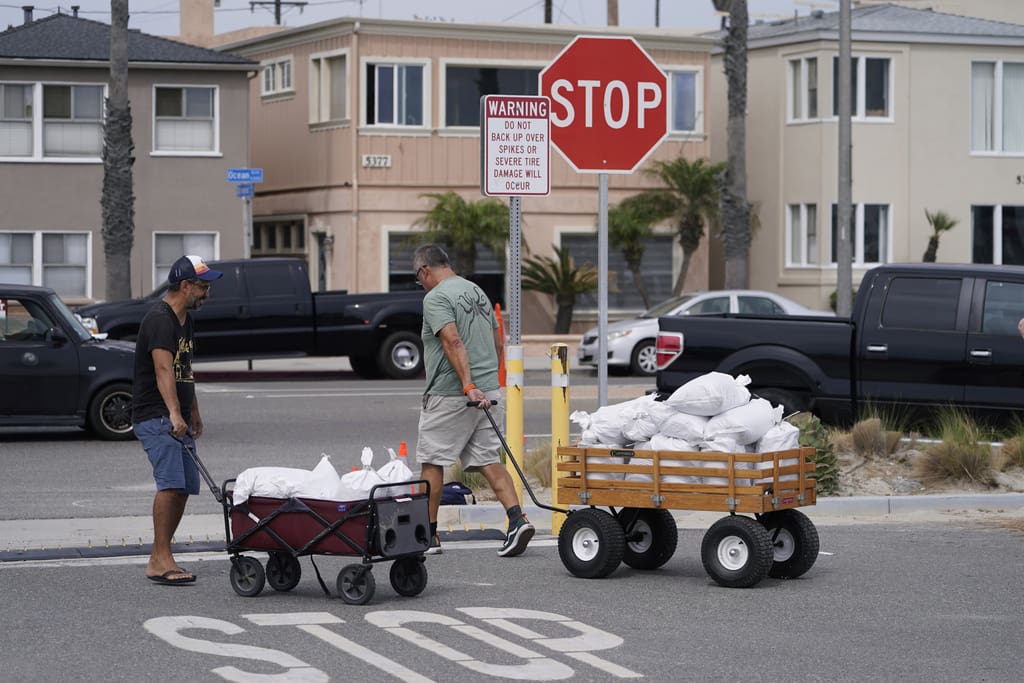ENSENADA, Mexico — Tropical Storm Hilary, weakened but still dangerous, swirled northward Sunday just off the coast of Mexico’s Baja California peninsula. While no longer a hurricane, it was carrying so much rain that forecasters said “catastrophic and life-threatening” flooding is likely across a broad region of the southwestern United States.
As of 11 a.m. Eastern Time, Hilary was located about 220 miles south-southeast of San Diego, the National Hurricane Center reported. Hilary had maximum sustained winds of 70 mph and was moving northwest at 25 mph.

The Mexican cities of Ensenada and Tijuana remained directly in the tropical storm’s path, and meteorologists warned that despite weakening, the storm remained treacherous.
One person drowned Saturday in the Mexican town of Santa Rosalia, on the peninsula’s eastern coast, when a vehicle was swept away in an overflowing stream. Rescue workers managed to save four other people, said Edith Aguilar Villavicencio, the mayor of Mulege township.
“Continued weakening due to cool waters, dry air, and land interaction is expected, but Hilary is forecast to remain a tropical storm before it reaches southern California later today,” wrote Hurricane Specialist John Cangiolosi. “The strongest winds are expected to be to the east of the center and in areas of high terrain.”
Hilary is poised to be the first tropical storm to hit Southern California in 84 years, bringing flash floods, mudslides, isolated tornadoes, high winds and power outages. Authorities issued an evacuation advisory for Santa Catalina Island, urging residents and beachgoers to leave the tourist destination 23 miles off the coast.
California Gov. Gavin Newsom proclaimed a state of emergency, and officials had urged people to finish their preparations before sundown Saturday. It would be too late by Sunday, one expert said.
Hilary already brought heavy rain and flooding to Mexico and the southwestern U.S. on Saturday, ahead of the storm’s expected Sunday border crossing. Forecasters warned it could dump up to 10 inches (25 centimeters) — a year’s worth of rain for some areas — in southern California and southern Nevada.
“This does not lessen the threat, especially the flood threat,” Jamie Rhome, the U.S. National Hurricane Center’s deputy director, said during a Saturday briefing to announce the storm’s downgraded status. “Don’t let the weakening trend and the intensity lower your guard.”
Meteorologists also expected the storm to churn up “life-threatening” surf and rip currents, including waves up to 40 feet (12 meters) high, along Mexico’s Pacific coast. Dozens sought refuge at storm shelters in the twin resorts of Los Cabos at the southern tip of the Baja peninsula, and firefighters rescued a family in San Jose del Cabo after the resort was hit by driving rain and wind.
In Tijuana, fire department head Rafael Carrillo voiced the fear at the back of everyone’s mind in the border city of 1.9 million people, particularly residents who live in homes on steep hillsides.
“If you hear noises, or the ground cracking, it is important for you to check it and get out as fast as possible, because the ground can weaken and your home could collapse,” Carrillo said.
Tijuana ordered all beaches closed Saturday, and set up a half dozen storm shelters at sports complexes and government offices.
Mexico’s navy evacuated 850 people from islands off the Baja coast, and deployed almost 3,000 troops for emergency operations. In La Paz, the picturesque capital of Baja California Sur state on the Sea of Cortez, police patrolled closed beaches to keep swimmers out of the whipped-up surf.
The U.S. hurricane center posted tropical storm and potential flood warnings for Southern California from the Pacific coast to interior mountains and deserts as far north as eastern Oregon and Idaho. The San Bernardino County sheriff issued evacuation warnings for several mountain and foothill communities ahead of the storm, while Orange County sent out its own alert for anyone living in a wildfire burn scar in the Santa Ana Mountains’ Silverado and Williams canyons.
Authorities in Los Angeles scrambled to get the homeless off the streets and into shelters, and officials ordered all state beaches in San Diego and Orange counties closed.
Across the region, municipalities ran out of free sandbags and grocery shelves emptied out as residents stockpiled supplies. The U.S. National Park Service closed California’s Joshua Tree National Park and Mojave National Preserve to keep visitors from becoming stranded amid flooding.
The White House said President Joe Biden had been briefed on the latest preparedness plans ahead of the hurricane’s turn to the U.S. “I urge everyone, everyone in the path of this storm, to take precautions and listen to the guidance of state and local officials,” he said.
The Federal Emergency Management Agency announced that it has officials inside California’s emergency preparedness office and teams on standby with food, water and other help as needed.
Support our partnership with the nonprofit AP. Give today
This story has been updated.


